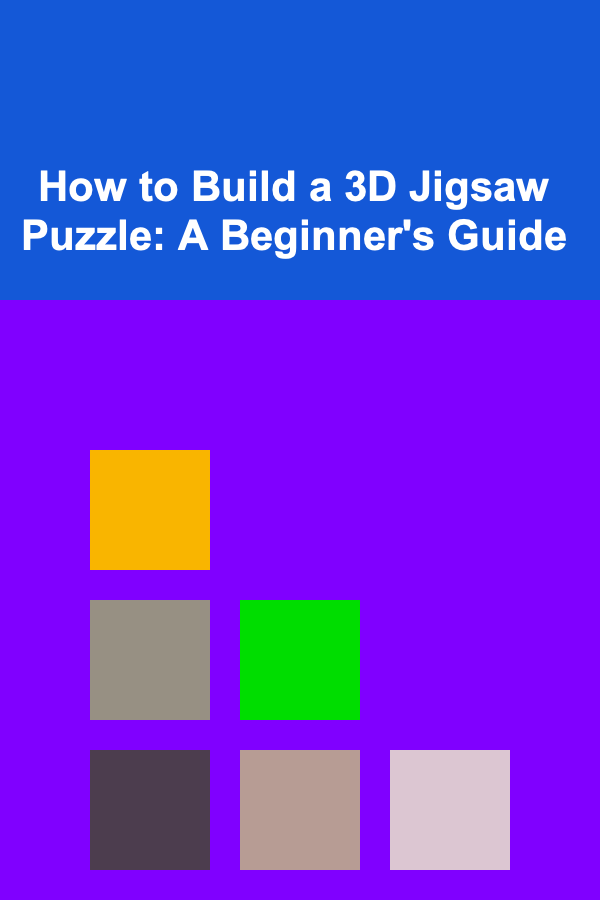
How to Build a 3D Jigsaw Puzzle: A Beginner's Guide
ebook include PDF & Audio bundle (Micro Guide)
$12.99$5.99
Limited Time Offer! Order within the next:

Building a 3D jigsaw puzzle can be a fun, challenging, and rewarding experience. Whether you're a beginner or looking to explore a new form of puzzle-solving, this guide will walk you through the essential steps and tips to help you build a 3D jigsaw puzzle from start to finish. Unlike traditional flat puzzles, 3D jigsaw puzzles require a unique approach due to their three-dimensional nature, involving creativity, precision, and an understanding of spatial relationships.
Understanding 3D Jigsaw Puzzles
3D jigsaw puzzles are a form of puzzle that, when completed, form a three-dimensional object. These can range from replicas of famous landmarks, architectural structures, and vehicles, to fantastical creations. Unlike the flat, two-dimensional counterparts, 3D puzzles include multiple pieces that interlock to build up in space, making the final result appear to stand or rotate. Building these types of puzzles requires different skills than traditional jigsaw puzzles, particularly a strong sense of spatial orientation and patience.
Types of 3D Jigsaw Puzzles
There are various types of 3D jigsaw puzzles available, including:
- Architecture and Landmarks: Puzzles that replicate famous buildings, monuments, or cities, such as the Eiffel Tower or Big Ben.
- Vehicles and Ships: Puzzles that create models of cars, airplanes, ships, and other transportation vehicles.
- Animals and Figurines: These involve creating three-dimensional animal shapes or human-like figures.
- Abstract Designs and Sculptures: Some puzzles focus on creating abstract 3D forms, which can be especially complex due to the lack of recognizable structure.
Each type presents its own unique challenges, from fitting together oddly shaped pieces to achieving symmetry in a complex object.
Gathering the Right Tools and Materials
Before you begin building your 3D puzzle, ensure you have the proper materials and workspace. This will not only make the process smoother but also enhance your overall experience.
Tools You'll Need:
- Puzzle Pieces: This is the most important material, obviously. Ensure that all the pieces are present and sorted before you start. Many 3D puzzles come with a numbered piece system to help with assembly.
- Instruction Manual: A good 3D puzzle will come with a detailed instruction manual that shows the steps required to complete the puzzle. These can sometimes be quite complex and require careful following.
- Tweezers: For positioning small pieces and fine adjustments, tweezers are a valuable tool.
- A Clean Workspace: A flat, spacious table or surface where you can lay out the pieces and organize them as you build is crucial.
- Optional Glue: Some puzzles may require a light touch of glue to secure pieces in place, though most modern 3D puzzles are designed to fit tightly without glue.
- A Ruler or Measuring Tape: Useful for checking symmetry and ensuring pieces align correctly.
Organizing Your Pieces
Take the time to organize the puzzle pieces before beginning the assembly. Sorting by color, shape, and size can make it easier to locate the right pieces when you need them. Some people even organize by the steps outlined in the instruction manual. This preparation step can save you time later on.
Understanding the Structure of 3D Puzzles
3D puzzles can seem overwhelming at first glance, but breaking down the structure into manageable sections can make the task much easier. Most puzzles will follow a logical sequence of construction, often starting with a stable base or central framework and working outward.
Key Concepts:
- Base/Foundation: Most 3D puzzles begin by building a solid foundation or platform to support the entire structure. This foundation will help hold the puzzle steady as you work on the remaining pieces.
- Structural Support: In many puzzles, especially those with larger or taller structures, pieces may interlock in a way that provides structural support. Understanding how these supports work can help avoid instability as you work.
- Layers and Heights: 3D puzzles often involve stacking pieces on top of each other. Pay attention to the height of each layer, ensuring that each piece fits snugly on the layer below it.
Step-by-Step Guide to Building Your 3D Puzzle
With the materials in hand and an understanding of the structure, it's time to begin the puzzle-building process. Here's a basic guide to help you get started.
Step 1: Build the Base
Most 3D puzzles will begin with the creation of a flat or slightly elevated base. This is the starting point for all the remaining pieces. Carefully follow the instructions to piece together the base, ensuring that each part fits securely. Some puzzles come with guides for aligning pieces, while others may have numbered tabs that make assembly easier.
Step 2: Assemble the Core Structure
Once the base is complete, you can begin building the core of the puzzle. This may involve stacking pieces, assembling arches, or working on the skeletal frame of the structure. Pay close attention to any special instructions related to aligning pieces or fitting specific components, as small misalignments can lead to difficulty later on.
Step 3: Build Up the Layers
As you continue building, start working your way upward by adding layers. Some 3D puzzles involve inserting rods or other supports to create a solid frame for each layer. Carefully fit the pieces together while maintaining symmetry. Take your time here, as proper alignment is crucial for the overall structure.
Step 4: Final Touches and Detailing
In the final stages, add any intricate details or decorative pieces to the top of your structure. These pieces will often be smaller and more delicate, so be sure to handle them with care. This is also when you'll want to ensure that everything is securely fitted and well-balanced.
Step 5: Inspect and Adjust
Once the puzzle is fully assembled, inspect the entire structure. Check for any loose or misaligned pieces. Make adjustments as necessary, and, if needed, secure them with a bit of glue to keep everything in place.
Common Challenges and How to Overcome Them
Building a 3D jigsaw puzzle can be challenging, especially for beginners. Here are some common issues you may encounter and tips on how to deal with them:
Problem 1: Pieces Not Fitting Together
If you find that pieces aren't fitting together, don't force them. Double-check the instructions and ensure that you're assembling the correct pieces. Sometimes, pieces can look similar but be slightly different, so careful inspection is key.
Solution: Check for incorrect piece placement, and if necessary, take a step back and review the instructions to ensure you're following the correct sequence.
Problem 2: Structure Becomes Wobbly
Some 3D puzzles may become unstable as you build, especially if the base or core structure isn't securely attached.
Solution: Reinforce the base and core structure by ensuring each piece is securely placed and that the supports are solid. Many 3D puzzles include stabilizing pieces or instructions for reinforcing certain sections.
Problem 3: Missing Pieces
It's always frustrating to realize that you're missing a piece, but it can happen. Missing pieces are usually rare, but it's best to check the box or bag before beginning.
Solution: If a piece is missing, contact the manufacturer for a replacement. Some puzzle makers offer replacements for lost or damaged pieces, especially for high-quality puzzles.
Advanced Tips for Experienced Builders
Once you've completed a few 3D puzzles, you may want to take your skills to the next level. Here are some advanced tips for experienced puzzle builders:
Tip 1: Customize Your Puzzle
Some 3D puzzles offer customization options. You can paint or decorate the completed structure to add a personal touch. Customization allows you to make your puzzle a one-of-a-kind piece of art.
Tip 2: Use a Puzzle Stand
If your puzzle is large or complex, you may want to display it on a stand. This can help maintain the structure's stability while also showcasing your hard work.
Tip 3: Try Complex Puzzles
Once you've built a few beginner puzzles, consider moving on to more advanced options. These might include puzzles with more intricate pieces, moving parts, or even puzzles that require a higher level of spatial reasoning.
Conclusion
Building a 3D jigsaw puzzle is a highly rewarding and enjoyable experience that allows you to test your problem-solving skills and creativity. Whether you're constructing a landmark, vehicle, or animal figure, the satisfaction of seeing your puzzle come to life in three dimensions is unparalleled. By following the steps outlined in this guide and overcoming common challenges, you can confidently embark on your 3D puzzle journey and create something truly remarkable. Happy puzzling!
Reading More From Our Other Websites
- [Biking 101] How to Upgrade Your Fixed Gear Bike for Better Performance
- [Personal Investment 101] How to Profit from Deep Learning without Writing Code
- [Personal Financial Planning 101] How to Create a Will: Protecting Your Assets and Loved Ones
- [Personal Investment 101] How to Invest in Green and Sustainable Companies for Ethical Growth
- [Ziplining Tip 101] How to Properly Fit and Adjust Your Ziplining Harness for Maximum Comfort
- [Home Storage Solution 101] How to Store Winter Gear in an Efficient and Accessible Way
- [Organization Tip 101] How to Maintain Craft Organization Year-Round
- [Hiking with Kids Tip 101] Capturing the Trail: Essential Photo Tips for Family Hiking Adventures
- [Personal Investment 101] How to Make Sense of Market Volatility and Still Profit
- [Home Staging 101] How to Create a Welcoming Entryway to Attract Buyers

How to Create a Drop Zone for Essentials in Your Entryway
Read More
HR Technology in Action: Leveraging Automation and Analytics to Transform Workplaces
Read More
Top Tips for Lowering Medical Expenses and Managing Health Costs
Read More
Mastering Deep-Frying Safely: A Comprehensive Guide
Read More
10 Tips for Fish Tank Care: A Daily and Weekly To-Do List
Read More
Internship Application Checklist: The Ultimate Guide for Students
Read MoreOther Products

How to Create a Drop Zone for Essentials in Your Entryway
Read More
HR Technology in Action: Leveraging Automation and Analytics to Transform Workplaces
Read More
Top Tips for Lowering Medical Expenses and Managing Health Costs
Read More
Mastering Deep-Frying Safely: A Comprehensive Guide
Read More
10 Tips for Fish Tank Care: A Daily and Weekly To-Do List
Read More